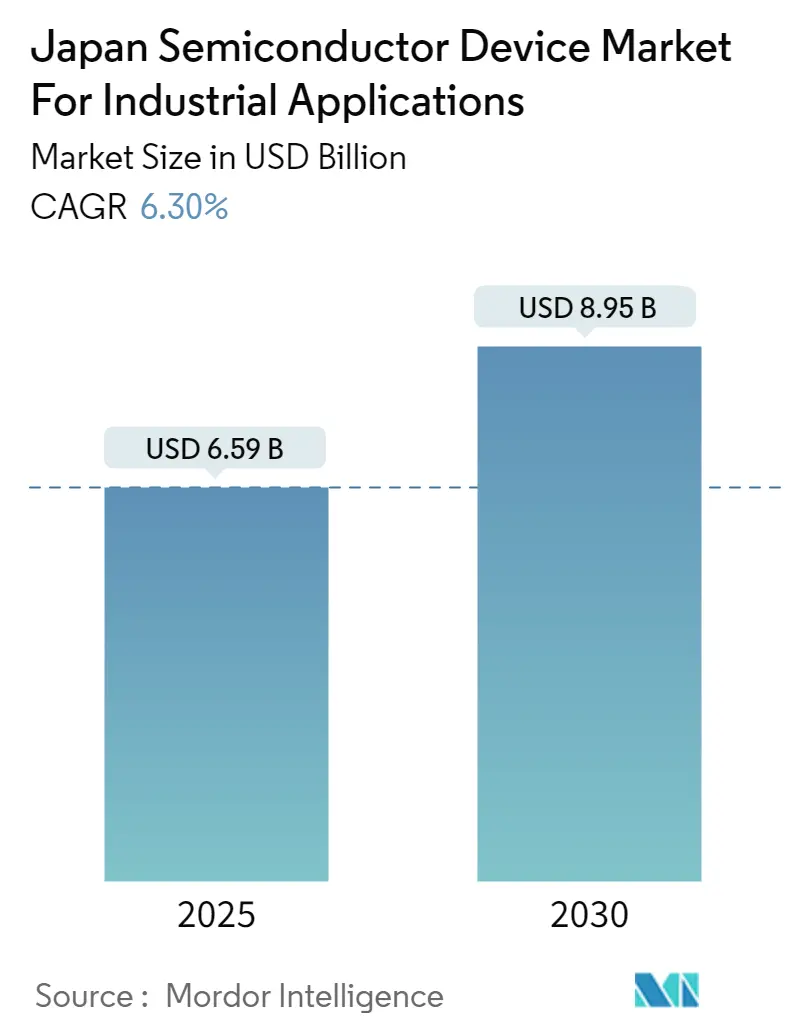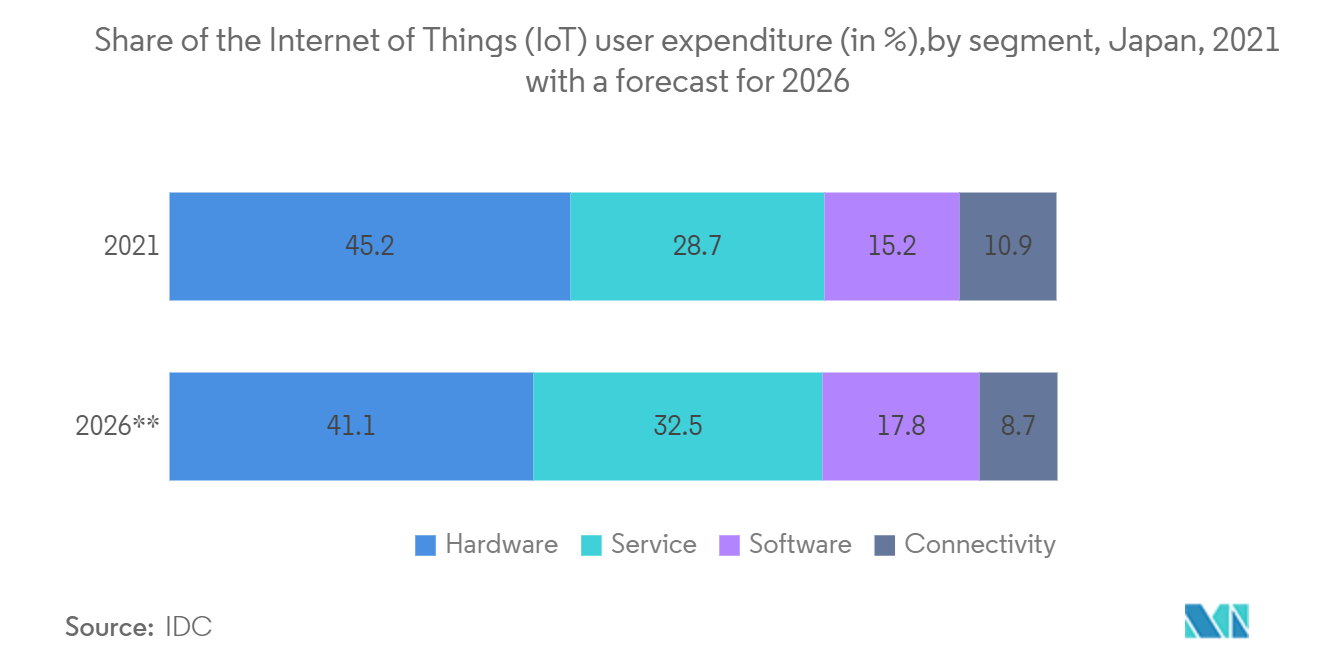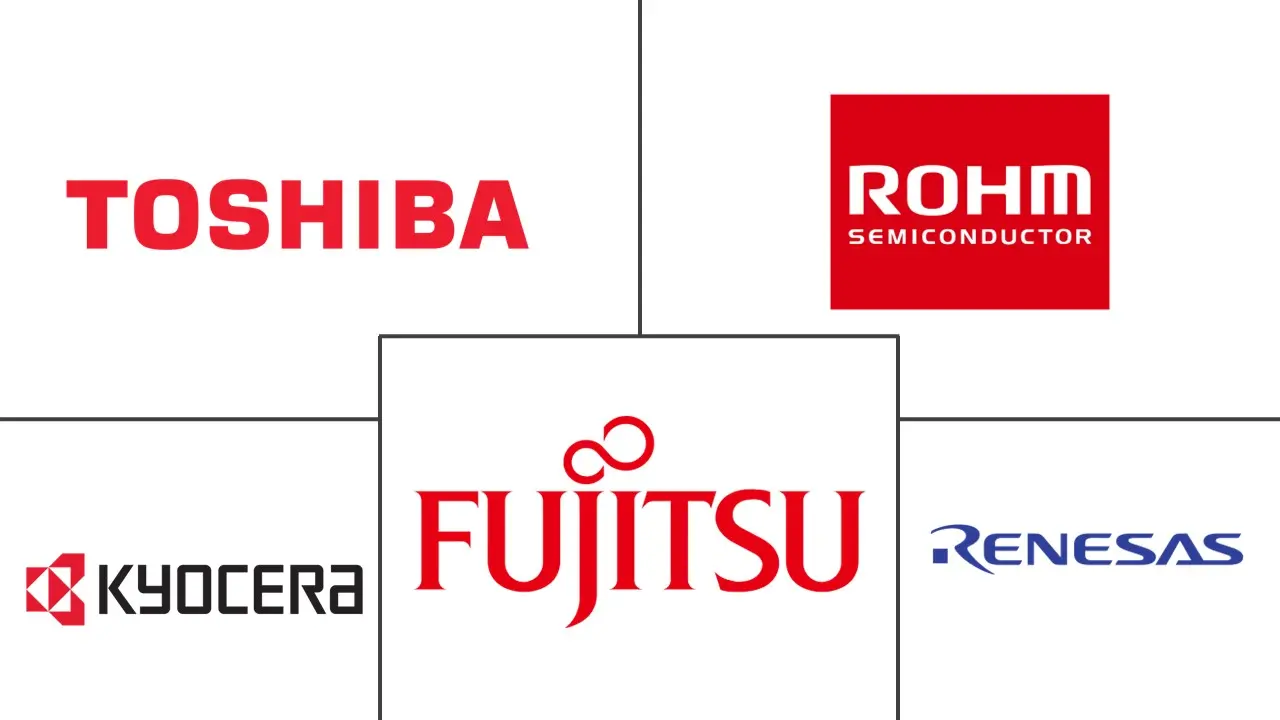Size and Share of Japan Semiconductor Device Market For Industrial Applications

Analysis of Japan Semiconductor Device Market For Industrial Applications by Mordor Intelligence
The Japan Semiconductor Device Market For Industrial Applications Industry is expected to grow from USD 6.59 billion in 2025 to USD 8.95 billion by 2030, at a CAGR of 6.3% during the forecast period (2025-2030).
Owing to increasing applications for power, semiconductors are an uninterruptible power supply, typically used to protect hardware such as computers, data centers, telecommunication equipment, or other electrical equipment. An unexpected power disruption could cause injuries, fatalities, serious business disruption, or data loss. Uninterruptible power supply systems usually contain batteries and an inverter that uses IGBT.
- The largest factor driving demand for semiconductor sales in Japan is the country's electronic products industry, one of the world's largest. According to the Japan Electronics and Information Technology Industries Association (JEITA), electronic device production in Japan in 2022 will be around JPY 11 trillion (USD 70 billion). The high demand for these products is one of the market's primary drivers.
- Furthermore, the automotive industry accounts for a significant share of the total demand for semiconductors in the country. The automotive industry's migration from fossil fuel vehicles to hybrid and electric vehicles is driving strong demand for power devices. The leading power device makers drive to develop higher-performance devices on new materials such as SiC and GaN.
- Increasing installations of robots create a positive outlook for the market. Japan is also the largest market for industrial robots. According to a recent report from the International Federation of Robotics (IFR), Japanese manufacturers account for 45% of the global supply of industrial robots, making them the top manufacturer of industrial robots compete. The country has also been rapidly increasing its production capacity. In 2022, recently increased 3.4% YoY to JPY 218.3 billion (USD 1.38 billion), marking the ninth consecutive quarter of YoY growth.
- Moreover, Research and Development activities production continue to rise in the region, which will help foster product innovation. For instance, in July 2022, the United States and Japan world's production recently decided to launch a new joint international semiconductor research hub. They agreed to work on joint research for next-generation semiconductors.
- Furthermore, the Japanese government approved a plan known as the 'Rebirth of Japan,' which outlines the route toward strengthening the manufacturing sector further by targeting the development of USD 1.3 trillion. By 2023, companies in the industrial sector are expected to accumulate revenues by as much as USD 490 billion in production due to Industry 4.0.
Insights and Trends of Japan Semiconductor Device Market For Industrial Applications
Automotive Industry Expected to Have Significant Growth
- Electric cars are becoming common on the road nowadays, with prices decreasing and ranges increasing. In addition, electric vehicles are becoming common on the road nowadays, with prices decreasing and ranges increasing. According to AIRIA Japan, as of March 31, 2022, the number of battery-electric passenger cars reached approximately 138.33 thousand, increasing from around 125.86 thousand in the previous year in Japan.
- In the past few years, many OEMs have announced billions of dollars worth of investment in EVs, which is also strong due to the restrictions on CO2 emissions. Key steps will be taken in the coming years, and a higher percentage of EVs on the road will be seen. Semiconductors play a key role in both electric vehicles and those with internal combustion engines.
- For instance, Toyota announced its Battery EV Strategy in December 2021, aiming to release 30 battery EV models by 2030 and sell 3.5 million units globally annually. Expectations for Japan's largest automaker and its impact on promoting EV use in Japan are high.
- The number of electric vehicles out on the streets is expected to keep multiplying as governments continue incentivizing clean energy and manufacturers find ways to make their cars more accessible. A big part of making that possible is the ongoing innovation in battery technology, driven by the demand for smaller, lighter, and safer batteries that charge faster and last longer. For instance, Tesla, which uses a rapid charging solution, is already using SiC within its vehicle architectures today.
- SiC semiconductors are ideal for onboard chargers and inverters used within plug-in hybrid (PHEV) and fully electric vehicles (EVs). This is because their energy efficiency is significantly higher compared to traditional silicon. For instance, Japan aims to achieve net-zero emissions by 2050 and cut emissions by 46% by 2030. The government applications and the transition to EV recognition assist the country's decarbonization efforts. First, it intends to prohibit the sale of gasoline-powered automobiles by the mid-2030s. It also intends to make electric vehicles more affordable to consumers. Meanwhile, subsidies are now limited to JPY 800,000.
- To ensure that EVs can operate over long distances and charge within a reasonable timeframe, the vehicle's power electronics must be capable of handling high temperatures. SiC semiconductors benefit from more than 95% energy efficiency, i.e., only 5% of the energy is lost as heat during power conversion instances, such as recharging the vehicle at a high-power rapid-charger.
- STMicroelectronics announced new automotive microcontrollers (MCUs) optimized for electric vehicles in February 2022. New STMicroelectronics automotive microcontrollers (MCUs) are designed for electric vehicles and centralized (zonal and domain) electronic architectures. The new Stellar E MCUs from STMicroelectronics are designed for next-generation software-defined EVs and feature on-chip high-speed control-loop processing. This platform enables a new value chain for EVs with the new Stellar E devices.

Smart Infrastructure to drive the growth
Smart infrastructure includes using sensors and smart grid technologies to facilitate smart water and energy networks, streets, buildings, and so forth. The smart grid, as compared to the conventional grid, is automated, highly integrated, technology-driven, and modernized. The smart grid will transform electrical networks, their topology, and power system operation in the coming years.
Further, power electronic systems, which convert and process electric energy from one form to another, are critical for smart grid implementation. As the cornerstone technology in any power electronics system, power semiconductor devices enable power electronics systems to reach ultrahigh efficiency and high-power capacity needed for various smart grid and renewable energy system applications.
Further, using efficient power semiconductors and advanced sensor and security solutions allows for designing effective, reliable, and multi-dimensional robots.
The increasing demand for data centers also boosts the demand for semiconductors like memory components. The presence of significant cloud technology enablers, such as SAS, and the growing geographic footprint of cloud service providers, like Amazon Web Services (AWS), Microsoft Azure, and Google Cloud, focused on building data centers in Japan, contributing to the growth of the Japan data center market.
For instance, in October 2022, Google planned to establish its first data center in Japan by 2023. The data center will be located in Inzai City, Chiba, and will be part of the company's USD 730 million infrastructure fund, which will continue through 2024.

Competitive Landscape
Japan Semiconductor Device Market fragmented with the presence of major players like Intel Corporation, Nvidia Corporation, Kyocera Corporation, Qualcomm Technologies Inc., and STMicroelectronics NV. Players in the market are adopting strategies such as partnerships and acquisitions to enhance their product offerings and gain sustainable competitive advantage.
- December 2022: Mitsubishi Electric Corporation announced that its new SLIMDIP-Z power semiconductor module would be available in February 2023, with an extra-high 30A rated current for use in inverter systems of home appliances. The small module will enable the SLIMDIPTM series to meet a broader range of power and size requirements for inverter units, specifically by simplifying and downsizing systems for multifunctional and sophisticated products like air conditioners, washing machines, and refrigerators.
- July 2022: Japan established an R&D center for next-generation 2-nanometer chips in collaboration with the United States to develop secure chip supply chains amid tensions surrounding industry leader Taiwan. The facility was established by a new Japanese chip research institution, which is set to open this year and will use equipment and talent from the planned US National Semiconductor Technology Centre. The R&D center included a prototype production line to mass-produce the chips in the United States as early as 2025.
Leaders of Japan Semiconductor Device Market For Industrial Applications
-
Kyocera Corporation
-
Toshiba Corporation
-
Fujitsu Semiconductor Ltd
-
Rohm Co. LTD
-
Renesas Electronics Corporation
- *Disclaimer: Major Players sorted in no particular order

Recent Industry Developments
- March 2023: Rapidus, a Japanese government-backed chipmaker, announced plans to build a cutting-edge semiconductor manufacturing plant in Hokkaido, northern Japan, to begin mass production of chips with cutting-edge 2-nanometer (nm) technology in five years. The plant will be built in Chitose, a manufacturing center on Japan's northernmost island of Hokkaido.
- March 2023: Mitsubishi Electric Corporation ranked fourth globally and first among Japanese companies in international patent applications filed in 2022, according to Switzerland's World Intellectual Property Organisation (WIPO). Mitsubishi Electric carefully aligns intellectual property (IP) activities with the company's business and R&D strategies, positioning IP as a critical business resource for future growth and development.
- January 2023: TDK Corporation announced the InvenSense SmartBug 2.0, a smart remote data-collection module for IoT with numerous new and exciting features for consumer and IoT applications. The user interface, BLE, WIFI, USB, SD card logging, and previous applications such as asset monitoring, smart door lock, and sensor fusion are all retained in SmartBug 2.0, preserving the original SmartBug experience.
Scope of Report on Japan Semiconductor Device Market For Industrial Applications
A semiconductor device is an electronic component that makes use of the electronic properties of semiconductor material. Its conductivity is intermediate between that of conductors and insulators. In most applications, semiconductor devices have replaced vacuum tubes.
Semiconductors are made as single discrete devices and integrated circuit (IC) chips, which are made up of two or more devices that can range from hundreds to billions and are manufactured and interconnected on a single semiconductor wafer known as a substrate.
Japan Semiconductor Device Market for industrial applications is segmented by device type (discreet semiconductors, optoelectronics, sensors, integrated circuits [analog, logic, memory, micro [microprocessors, microcontrollers, digital signal processors]]). The report offers market forecasts and size in value (USD) for all the above segments.
| Discrete Semiconductors | ||
| Optoelectronics | ||
| Sensors | ||
| Integrated Circuits | Analog | |
| Logic | ||
| Memory | ||
| Micro | Microprocessors (MPU) | |
| Microcontrollers (MCU) | ||
| Digital Signal Processors | ||
| By Device Type | Discrete Semiconductors | ||
| Optoelectronics | |||
| Sensors | |||
| Integrated Circuits | Analog | ||
| Logic | |||
| Memory | |||
| Micro | Microprocessors (MPU) | ||
| Microcontrollers (MCU) | |||
| Digital Signal Processors | |||
Key Questions Answered in the Report
How big is the Japan Semiconductor Device Market For Industrial Applications Industry?
The Japan Semiconductor Device Market For Industrial Applications Industry size is expected to reach USD 6.59 billion in 2025 and grow at a CAGR of 6.30% to reach USD 8.95 billion by 2030.
What is the current Japan Semiconductor Device Market For Industrial Applications Industry size?
In 2025, the Japan Semiconductor Device Market For Industrial Applications Industry size is expected to reach USD 6.59 billion.
Who are the key players in Japan Semiconductor Device Market For Industrial Applications Industry?
Kyocera Corporation, Toshiba Corporation, Fujitsu Semiconductor Ltd, Rohm Co. LTD and Renesas Electronics Corporation are the major companies operating in the Japan Semiconductor Device Market For Industrial Applications Industry.
What years does this Japan Semiconductor Device Market For Industrial Applications Industry cover, and what was the market size in 2024?
In 2024, the Japan Semiconductor Device Market For Industrial Applications Industry size was estimated at USD 6.17 billion. The report covers the Japan Semiconductor Device Market For Industrial Applications Industry historical market size for years: 2019, 2020, 2021, 2022, 2023 and 2024. The report also forecasts the Japan Semiconductor Device Market For Industrial Applications Industry size for years: 2025, 2026, 2027, 2028, 2029 and 2030.
Page last updated on:
Report on Japan Semiconductor Device Market For Industrial Applications
Statistics for the 2025 Japan Semiconductor Device For Industrial Applications market share, size and revenue growth rate, created by Mordor Intelligence™ Industry Reports. Japan Semiconductor Device For Industrial Applications analysis includes a market forecast outlook for 2025 to 2030 and historical overview. Get a sample of this industry analysis as a free report PDF download.



